Versions Compared
Key
- This line was added.
- This line was removed.
- Formatting was changed.


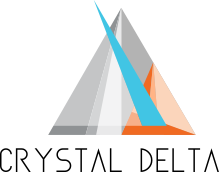
MELBOURNE
CHENNAI
| Table of Contents |
|---|
Welcome to Loree Admin Dashboard
Glad! Managing Loree editor interface features via Loree Admin dashboard.
Navigation to Loree Admin Dashboard
Happy to help you to take a tour of the Loree Admin Dashboard!
For navigating into the Loree Admin Dashboard, the user should have been added to the Loree-Admin roles in the Settings → Admins. Please contact your Canvas account admin for the Admin dashboard access.
Once, the user is added to the Loree-Admin role, the user can see the Admin button in the top right corner of the Modules page of the Loree LTI in the Canvas. By clicking the Admin button, the user can manage the features of the Loree editor via the Loree Admin Dashboard. We have an organization limit on the admin dashboard. So we will be able to view only the status in the admin dashboard within the organization. This will keep the organization’s data protected.

To exit the Admin Dashboard we have to click on Exit Admin in the top right corner of the Admin Dashboard page.

Roles & Features
Once after switching to the Loree Admin Dashboard by clicking the Admin button, the user will be able to see the Roles & Features Accordions and their corresponding Tabs,
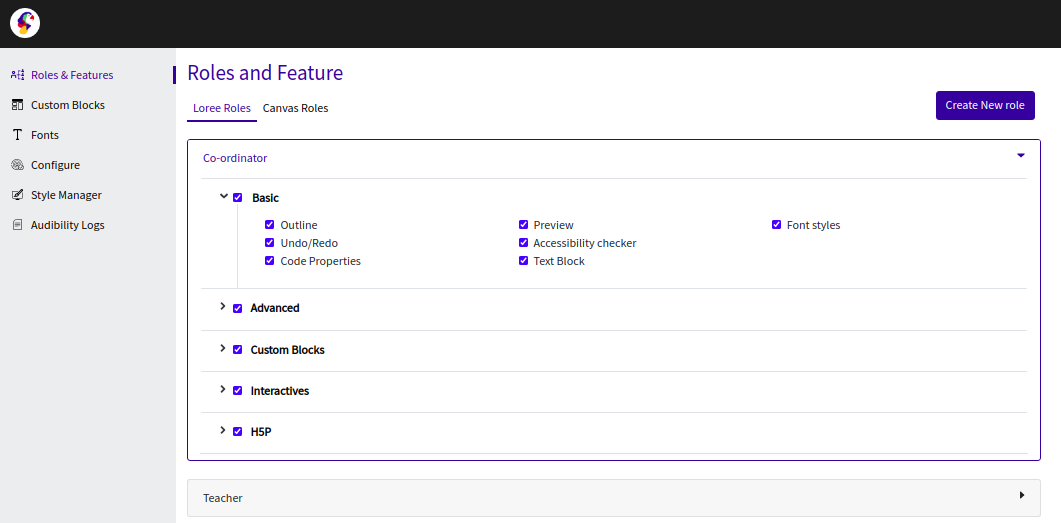
Loree Roles
Loree Roles will take care of the features for a particular role. By default, the Teacher and Designer Loree Role with all the features enabled will be created by Loree. In detail, when the Admin enables/disables features for a role say Teacher or Designer, or Create New Role (the admin can create a new role by clicking the Click New Role button in the right corner) say Role 1 or Role 2, these roles should be mapped with the Canvas Roles (Course role of a user) to get the desired features in the Loree editor.
Note: Account admin of the Canvas instance will get all Loree features by default.
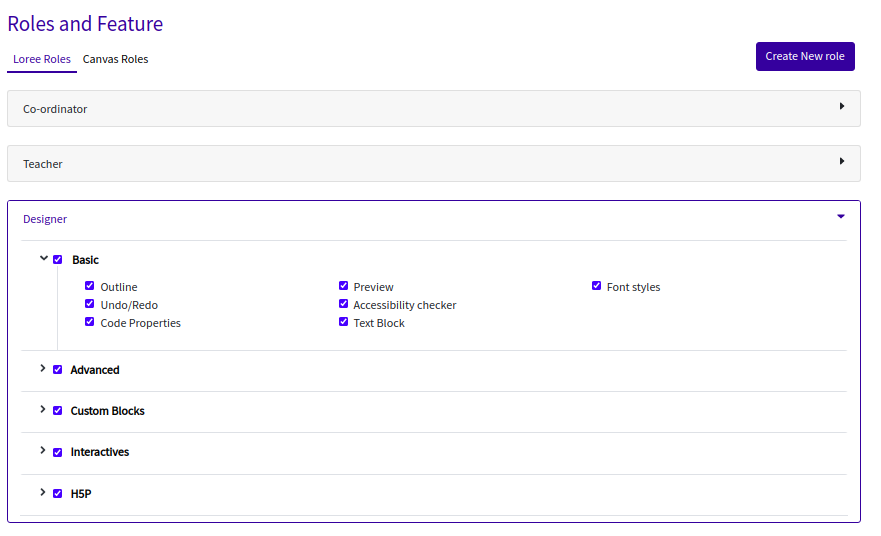
Canvas Roles
Canvas Roles will fetch all the roles in the sub-account of the course that you have entered. And if you have entered a course that is not created under any sub-account then your Canvas instance will show all the Root account roles and if the Admin switches to Sub-Account then it will fetch the roles in the particular Sub-Account. Once the Loree Roles are created by using the Loree default role, the Loree Roles should be mapped with the Canvas role which is the role based on the particular course role(Canvas course navigation → People → role assigned).
Note: ‘Select role’ (default - dropdown select) will not assign any features or roles.

If the Admin mapped the Loree roles for the 'Root Account' then it will reflect in all the Sub-Accounts and courses. Also, the Admin can map the Loree roles based on the Sub-Account in the Canvas instance by clicking the Root Account button.
Select Root Account accordion for its Sub-Accounts,

Sub-Account list will be fetched and can select the desired Sub-Account which roles to be mapped,
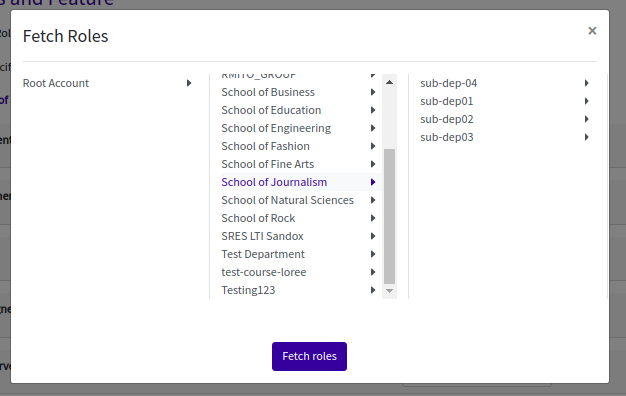
Click the 'Fetch roles' button to fetch the sub-Accounts roles, and map the desired Loree roles.
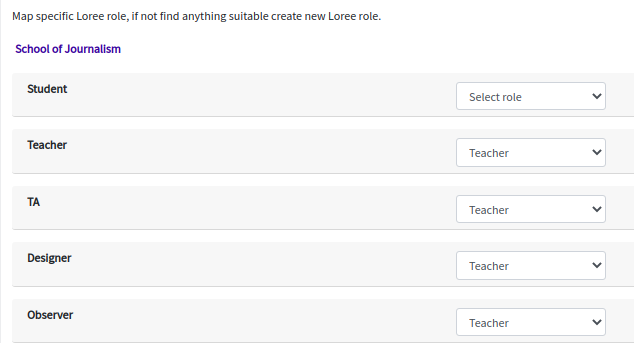
If the admin has entered a course that is created under a sub-account then the admin will only have the access to update roles and features for the course he has selected based on the sub-account of the course.
For Example:
If we are working on a course present in a sub-account named Migration training we can only map the roles for the Migration training Sub-account or its child account (sample, sample-dep-03) as mentioned in the screenshot below.

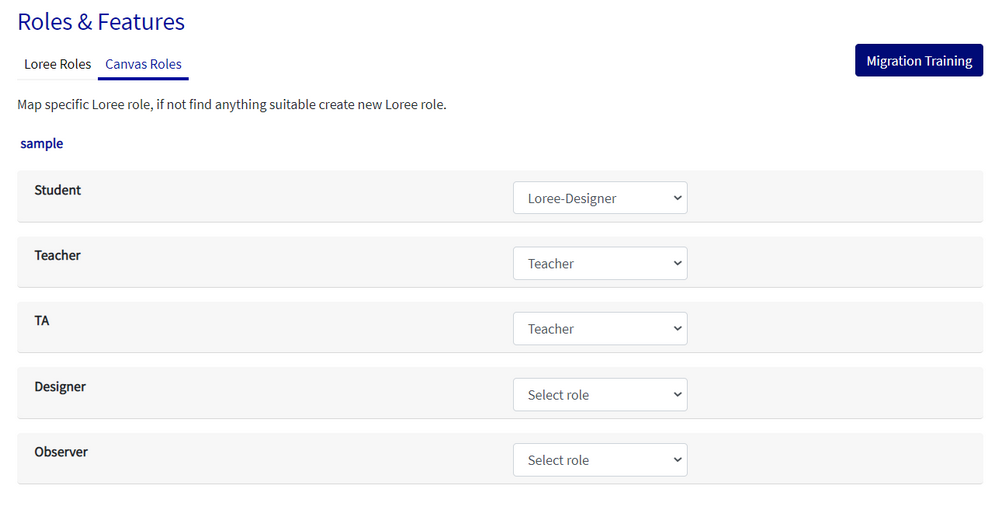
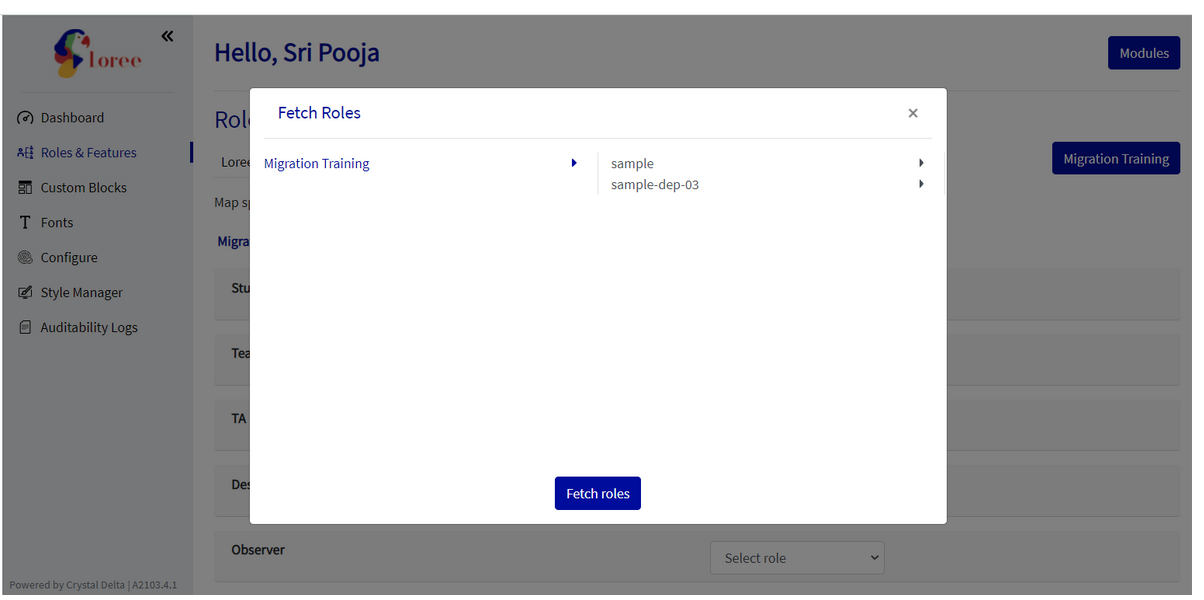
Custom Blocks
Custom blocks are the concept of saving or creating any of the template, row, or elements under any desired Name and Category. Here in the admin dashboard Custom Blocks, the admins can manage the Global and updating the template name, category and see the details of the Custom Blocks.
Custom Templates
Custom Templates are the templates we’re saving or creating inside the Loree editor. In this tab, the admins can update the template to Global or make the global template non-global, can see the details of the template like category, created by, created at, and last updated columns, and can also update the template Name and Category, Search the desired templates and even search the templates by Category just by clicking Category dropdown in the right corner. We have an organization limit on templates. So we will be able to view only the templates within the organization. Now we can only share/global/user templates within the organization.
Custom Templates with details, update button, search and category search buttons,
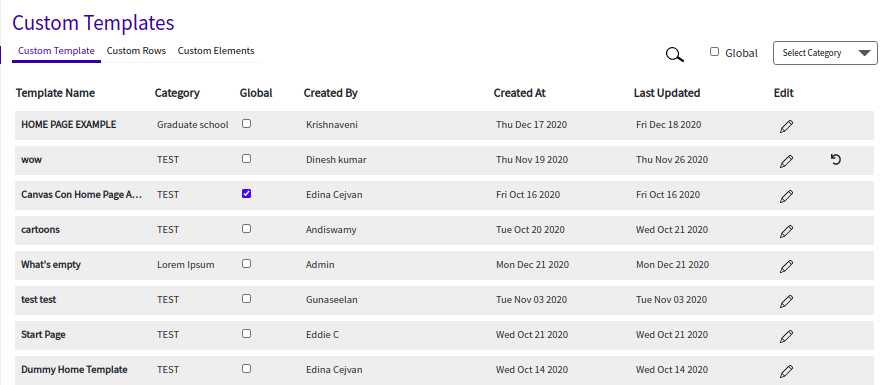
Search filter,

Category search option,

Custom Rows
When we save rows in the Loree editor, it will be fetched inside the Loree Admin dashboard. Custom Rows also have the options like making global and non-global, search option, category search, details of the template and update the row name and category.
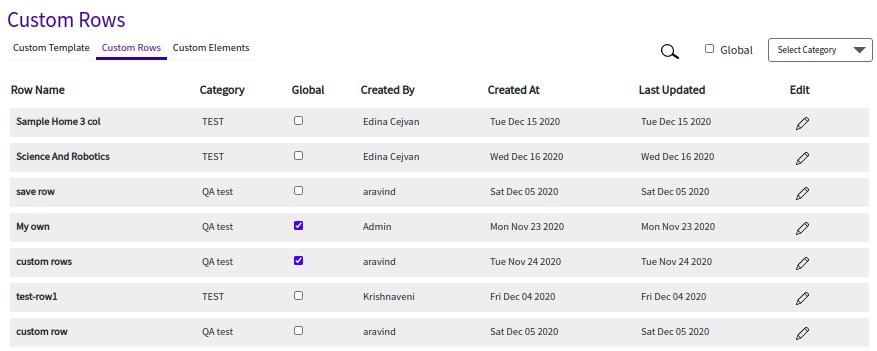
Custom Elements
When we save elements in the Loree editor, it will be fetched inside the Loree Admin dashboard. Custom Elements also have the options like making global and non-global, search option, category search, details of the template and update the row name and category.

Fonts
Loree has 900+ google fonts in the Fonts option in the Loree Admin dashboard. Any of the organization or desired fonts can be enabled and Save (in the right top corner) to get it in the Loree editor.
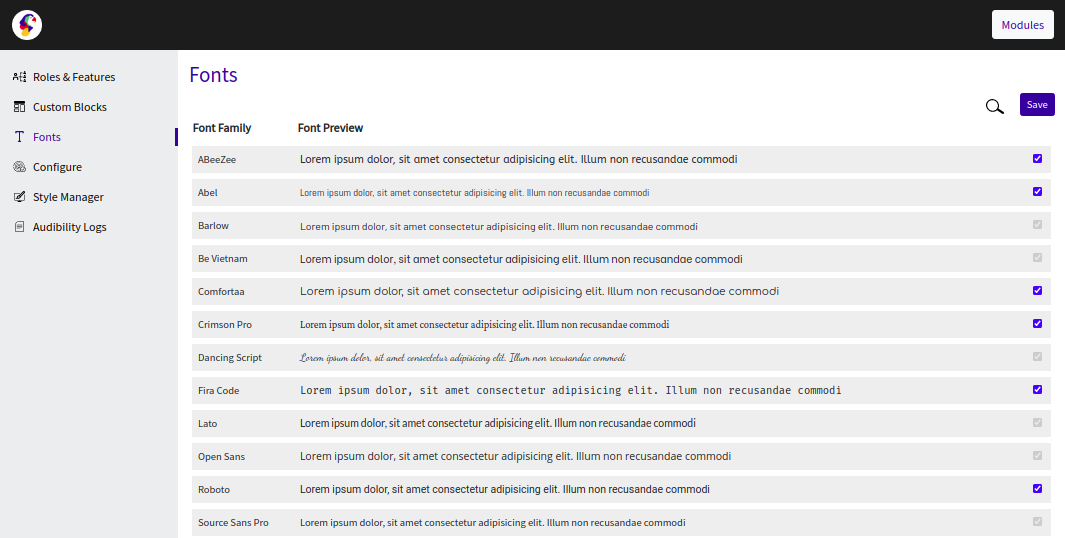
Default Fonts
Default fonts are the list of fonts that will be enabled and can’t be disabled in the admin dashboard and these default fonts will be in the Loree editor list, style manager list in the admin dashboard
The default fonts are,
Barlow
Be Vietnam
Dancing Script
Lato
Open Sans
Source Sans Pro
Arial
Helvetica
Times New Roman
Configure
Configure Accordion in the Loree Admin dashboard will carry
The Canvas credentials
This is a default configuration and can’t be updated.
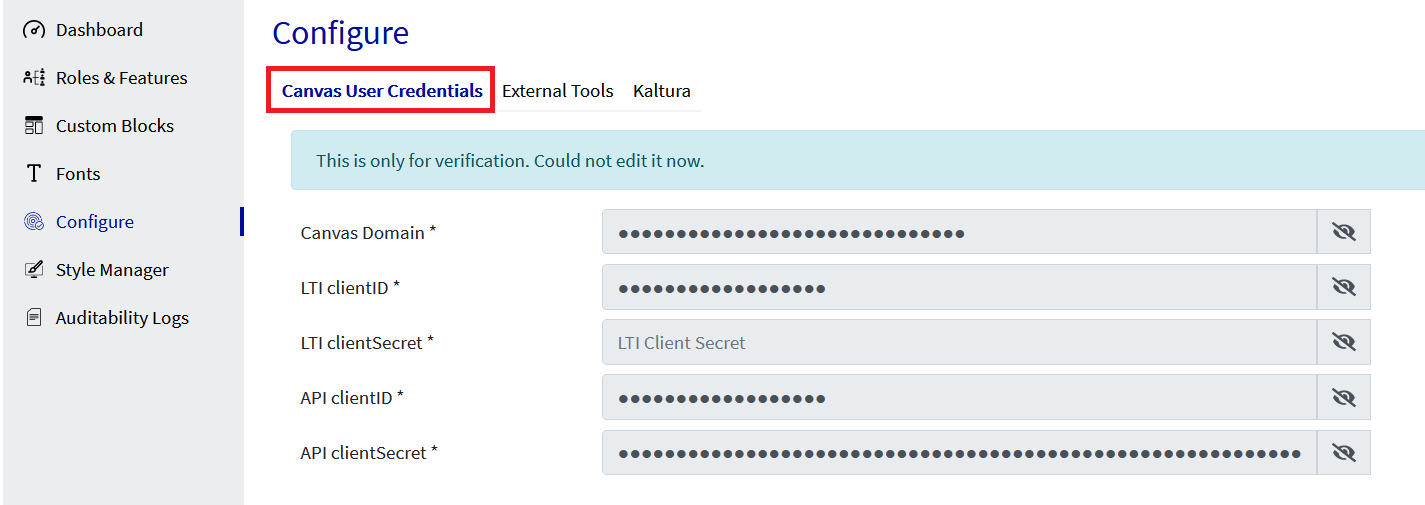
External tool configuration
Create a new External tool configuration UI in the Admin dashboard
We have provided an option to add External Tools inside the Loree Admin dashboard. After opening the Admin dashboard → Configure → External Tools → Add External Tool.
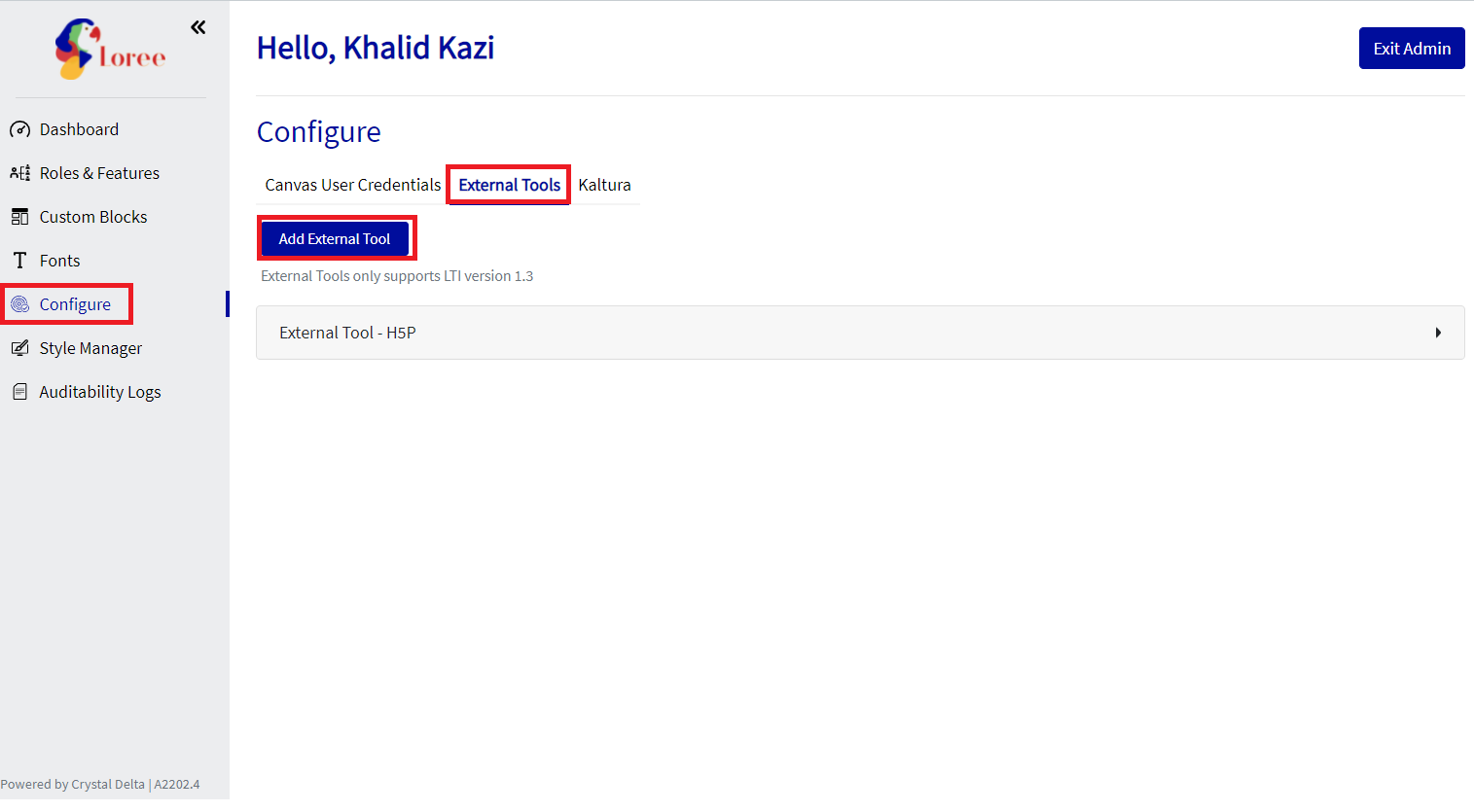
Once we click on Add External Tool we will get a popup window as Pick your tool type, We can select Others and click on Add.
While filling a new external tool field
Add External Tool button will be disabled once the admin clicks on the buttons and start filling data.

The Save button will be disabled until all the mandatory fields are filled and will enable once all the input data is updated.

Once the new external tool data is created and applied on Save by the admin user, the Add External Tool button will be enabled for the next creation.
If the admin user is canceling the external tool before saving it, then there will be an alert message on the screen as “Are you sure you want to cancel the tool creation? The new tool will be removed.“ If the admin user clicks Yes then the External Tool will not be added and the accordion will be deleted. If the admin user clicks No they can continue to create the External Tool.

Configuring tools UI as Tabs in the admin dashboard
The active tab from Canvas User Credentials (LMS User Credentials), External Tool, and Kaltura will be bold and underlined like in UI.
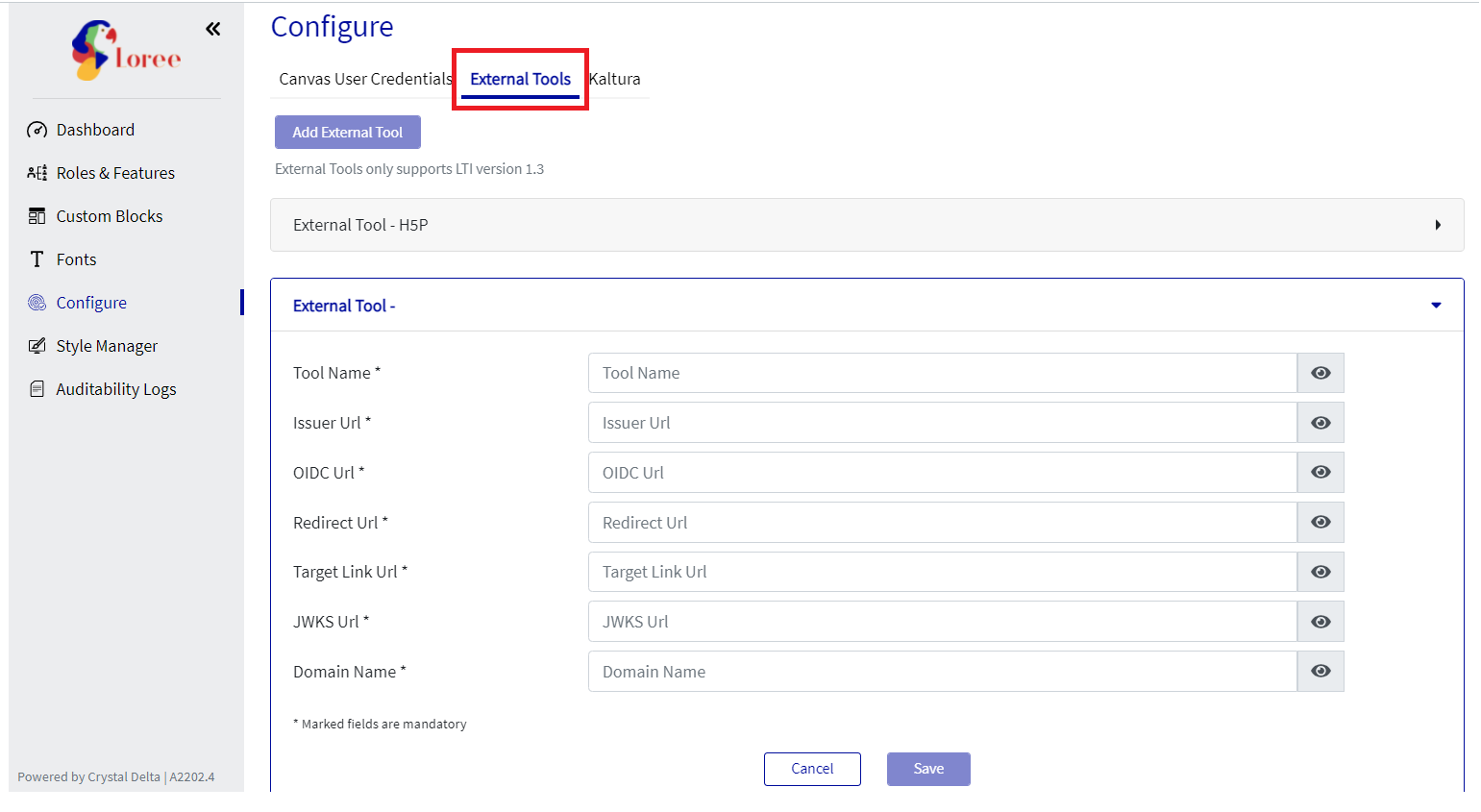
Once the Eye icon is clicked the inputs will be disabled and the admin cannot view will details also as shown in the screenshot below.
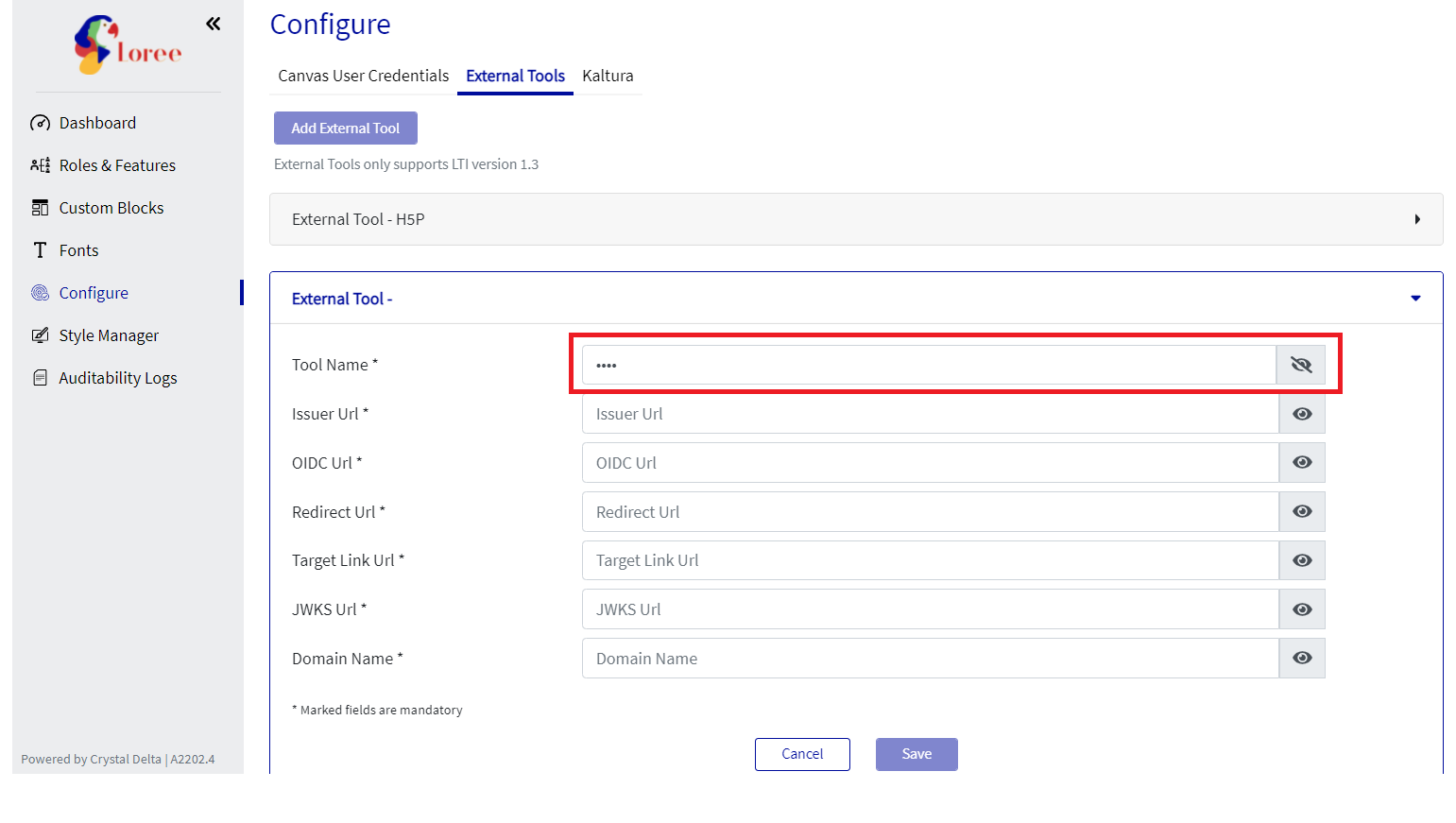
Edit the External tool configuration UI in the Admin dashboard
Once the External Tool is created admin can Edit the details by clicking on the Edit button.

Once the Admin clicks on the Edit button the fields that can be edited will be enabled and the Edit button will be disabled. Client ID, Client Secret key, and Deployment ID will remain disabled as those fields can’t be edited and are only updated at the backend.

After Editing the External tool details we can click on Update and the details will be updated and if we click cancel previously-stored details will be restored.
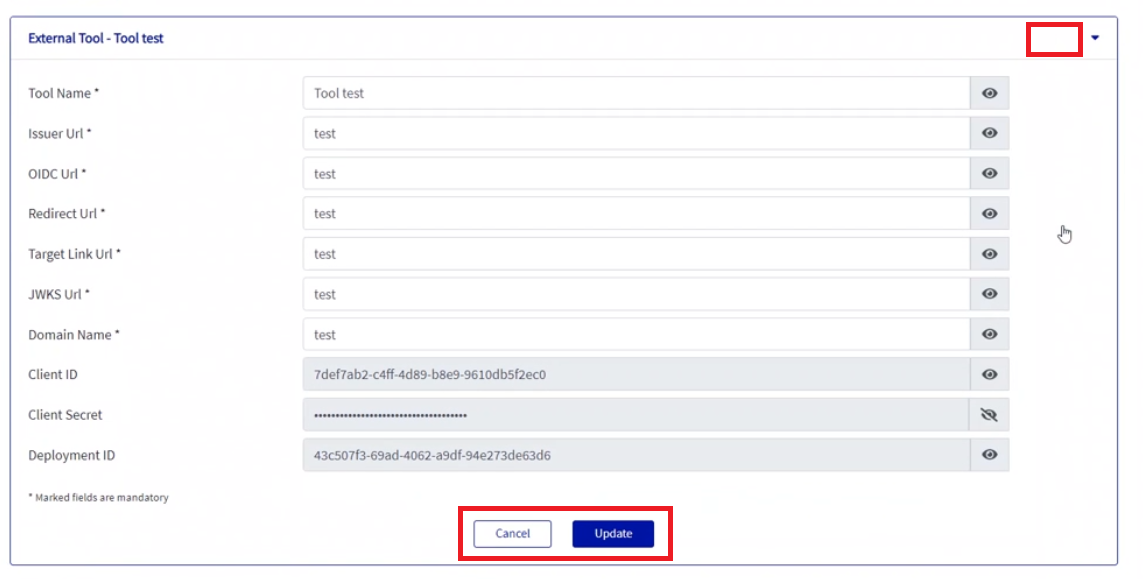
Kaltura credentials
This can be updated or added when Kaltura videos are in.

Style Manager
Style Manager Accordion in the Loree Admin dashboard will carry three amazing customization options in the Loree editor. The below sections will talk in detail about the Custom colors, Custom Headers, and Custom Links.
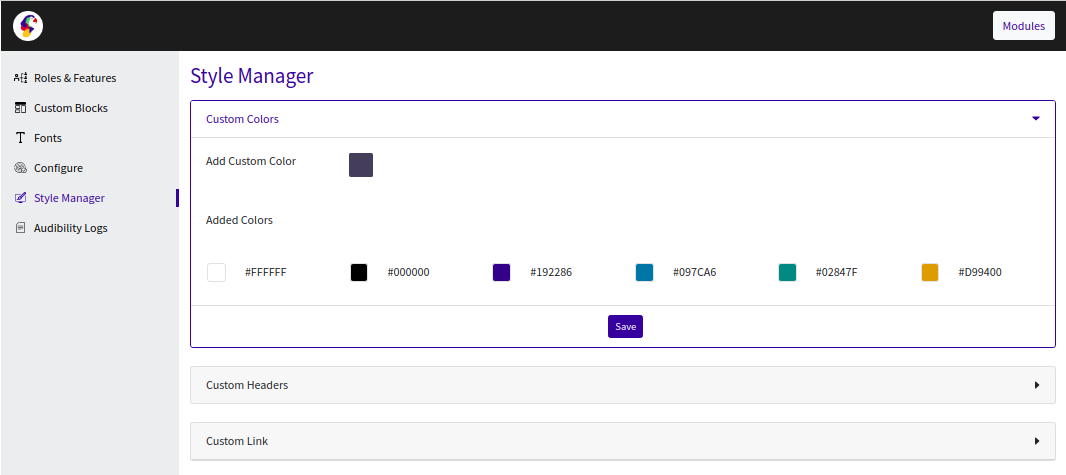 Image Removed
Image Removed Image Added
Image AddedCustom Colors
Custom Colors will carry a full-color spectrum palette in which any organizational or desired colors can be chosen and Saved (bottom of the Custom Colors accordion) to fetch inside the Loree editor to use for any of the Background, Border, or Font colors.
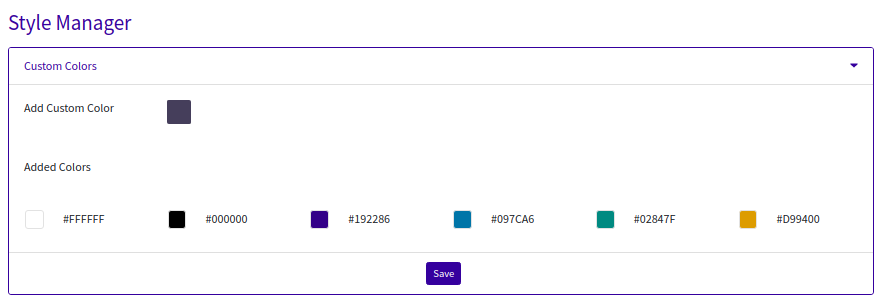 Image Removed
Image Removed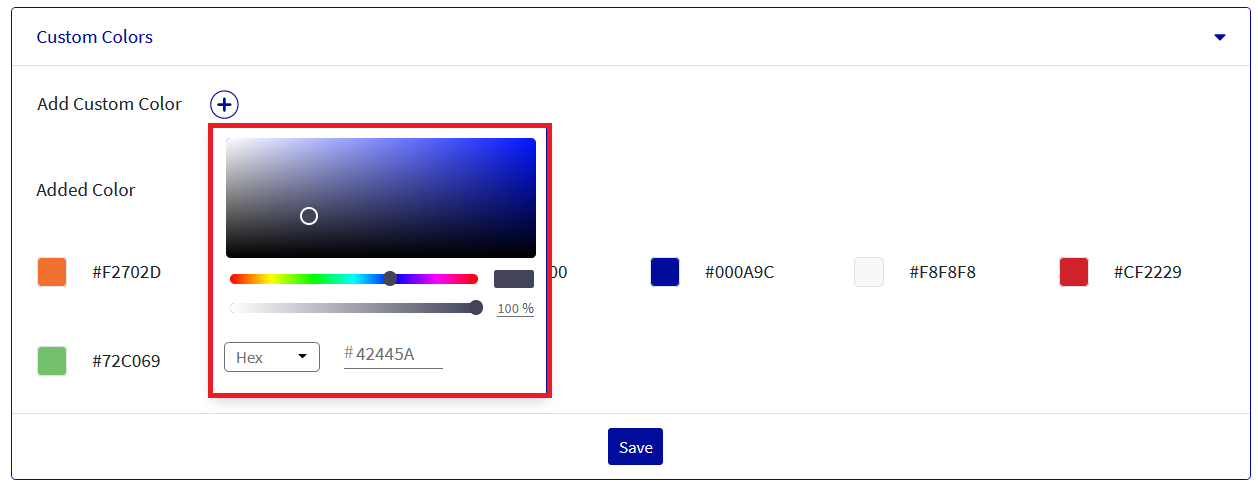 Image Added
Image AddedOnce we click on the (+) Icon and we will have the ability to either choose color from a color scaling tool, input a specific Hex code for the color or input a specific RGBA code of the color to be applied. We can choose options of Hex code and RGBA code from the dropdown.
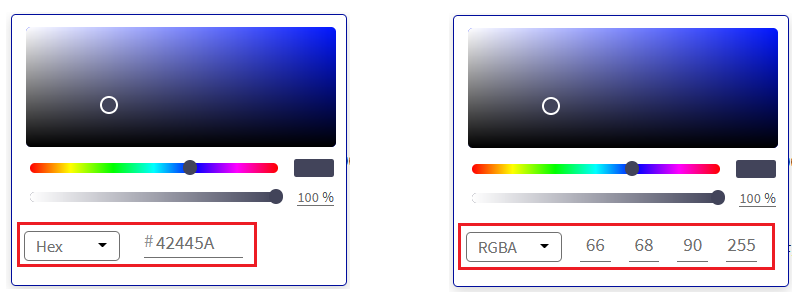 Image Added
Image AddedCustom Headers
In Custom Headers, the admin can set 6 headers and paragraph’s Font style and Font size and should Save them. When a Paragraph is used or any of the Headers are used the Font style and size set up in the Loree Admin dashboard will be reflected.
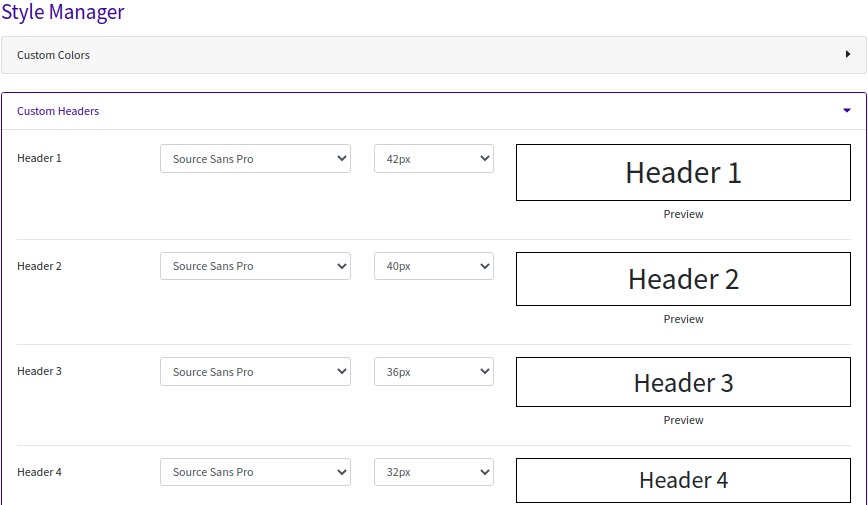

Custom Links
The Links can have colors and font styles like size and font family in Loree. When a Custom Links like its font family, size, link decoration, and link-style can be set in the Custom Links option in the Loree Admin dashboard to reflect in the Loree editor.
Note: All links like the external links or quick links for the whole organization will have the same link style applied in the Custom links in the Loree Admin dashboard.

Auditability Logs
Auditability Logs in the Admin dashboard would give the information about who is using or launching Loree editor in the Canvas instance.
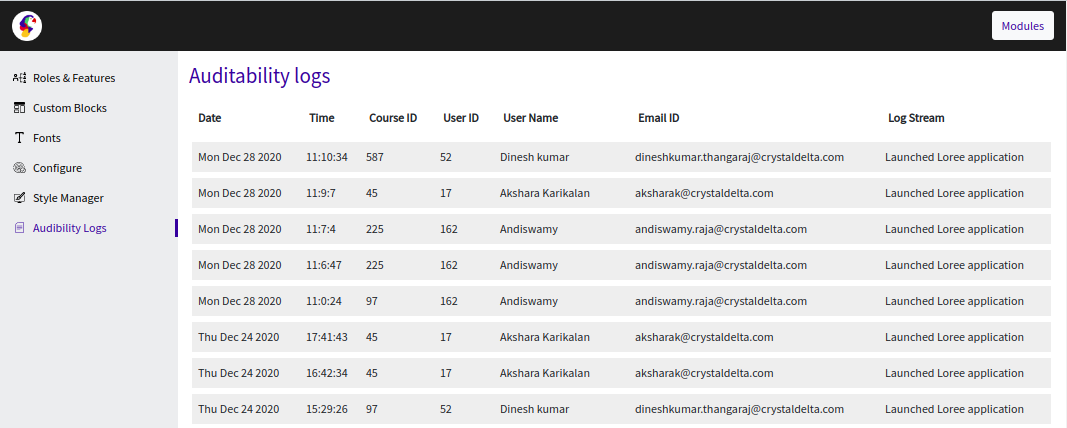
Thank you!!!